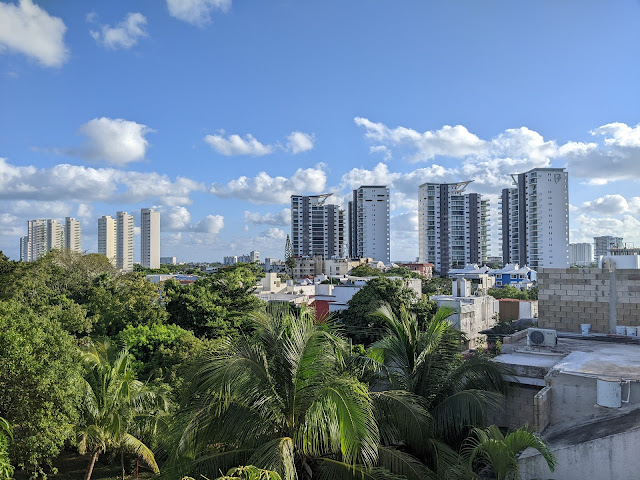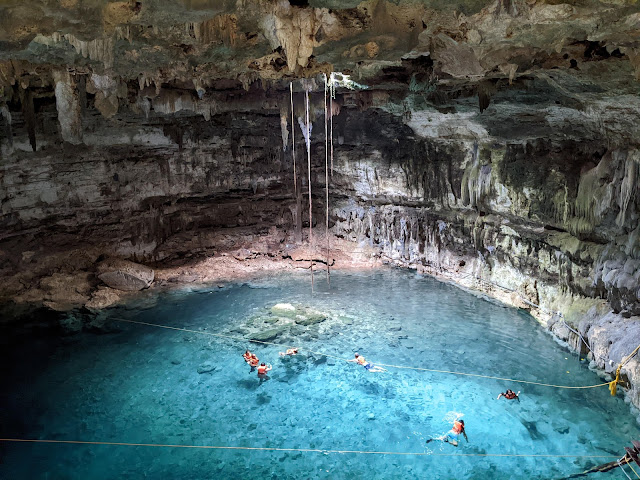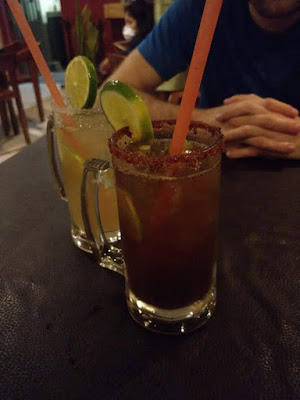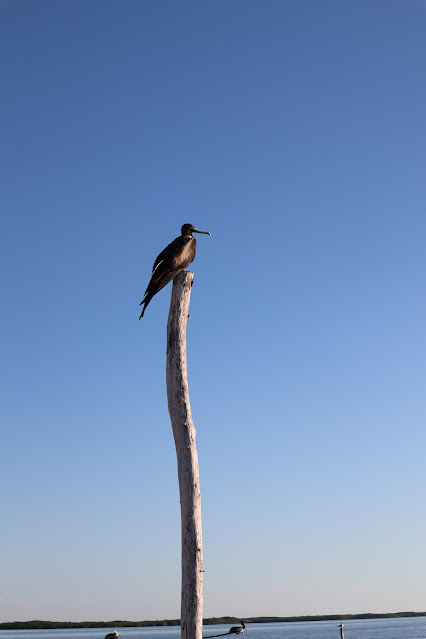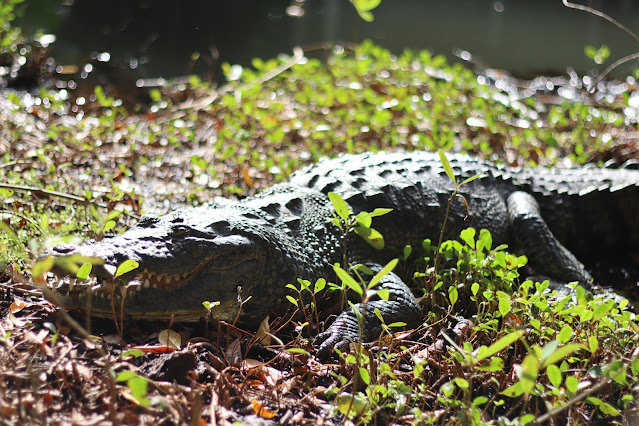apologies in advance - this is a long one!
Like
Valladolid, Mérida is a town with a lot of colonial buildings, and is known to be a cultural hub in Yucatán. There are a lot of tourists, and
therefore also a lot of air conditioned nice restaurants, souvenir shops and
even a “food court”/market that directly targets tourists (serving things like
pizza, burgers and sushi). As we arrived quite early in the day from Río
Lagartos, we only left our bags at our hotel and then headed out to find
breakfast. After wandering around quite a while, not really finding anything
appealing, we headed towards the main square. There we found the weekly Sunday
market which happened to include a number of food stalls. We ordered vegetarian
tortas (sandwiches) and they were really good. Somewhat more energized, we went exploring the city, which of course entailed looking at churches. We walked along
the famous street Paseo Montejo where all the grand colonial mansions are, and
all the way up to the Monumento de Patria.
As we no longer had the ocean breeze, the midday heat was intense, and we found our escape at local food courts for some lemonade or juice. In the evening we returned to the Sunday market for dinner and tried tacos with cochinita pibil as well as a Jamaica juice (made from hibiskus flower), both things that we have seen around Mexico or read about but hadn’t tried yet. We were not disappointed! However, continuing on this trend we decided to also try esquites, which is a snack that we’ve seen all around Mexico and which is very popular among locals: a cup of corn, mayo, cheese and chili. Maybe it’s an acquired taste, or maybe we just didn’t go to the right place – we decided to go for churros instead which is always a hit.
The next day for breakfast, we found a local mercado which would turn out to be a great place for food. As they were only open in the morning, we could go there for breakfast or an early lunch, and also take the opportunity to buy some fresh fruit. Here we tried relleno negro (which gets its black color from charred chilis) and had great panuchos, tortas and huevos.
The remaining time in Mérida we spent mostly at museums. There are a few in the center of town that are also free and very nice, including one with contemporary art, and the Palacio del Gobernador. Worth noting however is that several museums have little or no information in English, so at times we had to do with simply looking at the installations and pondering. We wanted to go to the World Maya Museum as well, but it required a bus and despite several tries we could not for the life of us figure out where to catch these buses. Everywhere online we read about Calle 60, and a local travel app also directed us there, but there was not a single bus that passed on Calle 60, so eventually we gave up.
In the evening we went to a cantina to get a feel of the pubs, and we had a very good time. The only downside was the music which was a bit too loud for comfortable conversations, but both the local beers and the mezcal we tried were good. We also got complementary botanas (nachos with a variety of dips) which were “included” but appeared on the tab for 3 pesos which is still a very reasonable price.
After Mérida we felt we had enough city life, and headed back towards the coast. We only spent two days in Bacalar, but we enjoyed them a lot. Bacalar is a small town situated by a big lagoon. The number one activity here is of course to get out on the water. We chose to do that by kayak. It was a beatufiul morning when we headed out – and we spent the day paddling past islands, scouting for birds, paddling to and swimming in cenotes that were in the actual lagoon, and having a beer on a jetty in the rain. All in all an, adventurous day just in our taste.
Next, we headed out to the seaside in Mahahual, which is a small town south of Tulum and Playa del Carmen, and which consists mainly of a long beach and the hotels and souvenir shops along it. We booked our stay at Blue Kay, which is kind of a fancy resort but that also has very cheap and simple cabañas right by the beach. They also had a gym and free yoga classes. The beach area is dreamy and instagram-friendly, as there are swings on the beach, hammocks in the water and plenty of sunbeds. The one thing that almost ruins the atmosphere but which brings in a big part of the income to this town is the huge cruise ships that arrive daily to drop off hundreds of tourists.
The first
thing we did when we came here though was to go to one of the many dive shops
in town. From Mahahual, you can dive along the coast , but you can also go out
to Banco Chinchorro, a reef about 1-2 hour boatride away which is the more
popular location. We picked a 2-day package that would give us one day at the
coast and one day at Chinchorro. But first, we get a full day relaxing at the
beach, reading books and eating fantastic shrimp tacos at a seafood restaurant
where we returned a few times.
Diving at
the coast was pretty nice, though “cold” – a mere 27C in the water required us
to put on an extra wetsuit so we wouldn’t get too cold. We saw a few nice
things – stingrays, turtles, lobsters and a decorator crab. The next day we’re
up early to head out to Chinchorro. Our first dive started out well with two
nursery sharks that tagged along throughout the dive, but it ended
spectacularly – dolphins. First two, then five, then ten, then twenty something
dolphins swimming nearby, jumping and playing in the water. We were all amazed
by this – not only seeing them but also hearing them, it felt surreal. When we
got back to the boat, the waves had gotten pretty big so we head to a nearby
island to wait it out a bit. The island was mainly mangrove and we
spotted a few crocodiles while we snacked on lunch. After a while it’s clear that
the weather is not getting any better, so we need to head back to town.
Equipped with rain jackets to protect against the splashing salt water and the
worst of the wind, our small boat took on some very big waves. Safe to say we
were all grateful when we were able to put our feet in the sand again. The day
left us all with a bit of mixed feelings, but in the end – there were dolphins.
That was pretty damn awesome.
One of the nights in Mahahual we found a local eatery with Oaxacan food. Fun, we thought, lots of new things on the menu to try! We ordered three of those unknown dishes upon which the waitress looked at us skeptically and explained that they were all quite big. Thus, we settled for only two. When they brought out the first dish, a tlayuda, we realized we would probably have been good with only that! It felt sort of like a pizza, but with a crispy tortilla base instead of bread. The second one, a huaracha (kind of like a very big panucho) had us full to our limits.
Palenque
was our last stop in Mexico, and one that we really, really liked. While we had
to do some boring stuff here as well, like figuring out where to get a covid
antigen test which we needed for Guatemala, the day trips we did were really
worth it. Firstly, we booked a waterfall tour. This tour is a full day as they
include a few hours of driving. The first of the two waterfalls, Misol-Ha, is a big one with a pool where you can
swim. You can also walk along a path behind the waterfall and visit a small
cave. Very impressive! The second waterfall, Agua Azul, was even better. Somewhat
similar to the Kuang Si falls in Laos the light blue cascades are
beautiful to look at. The cascades went on for a huge area, and while the parts
near the parking was crowded with tourists and vendors, the further we walked,
the more empty it got. A nice walk along the pools, a quick dip in the cool
water, and walking across a suspension bridge – and a couple of empanadas with
a beer before the drive back was the end of a perfect day.
The next morning we were up early, breakfast hunting on the streets near our hotel. We found a food cart selling tamales for about 12 pesos each, and we were happy to stand on the sidewalk munching on those together with the locals who stopped by on their way to work. After that we took a colectivo to the Maya ruins. Contrary to Chichén Itzá, these ruins are situated in the jungle which provides a lush and mysterious setting. We loved walking around this tranquil area in the morning sun, looking at the different temples. Before heading back to town, we decided to take a walk in the jungle following a trail near the entrance to the ruin. We didn’t really know where the trail would lead us, but were pleasantly surprised to discover several overgrown temples/buildings, hidden away among the trees, and completely by ourselves. We also spotted some howler monkeys high up in the trees. Another excellent adventure that I would highly recommend.
That was all for this long post, keep an eye out for the next one to read about our adventures in Guatemala!




















